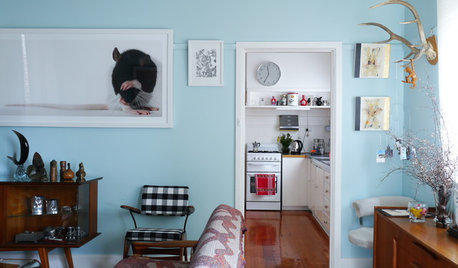Growing Gourds, Start To Finish, Final Chapter:
Gourd_Guy
19 years ago
Featured Answer
Sort by:Oldest
Comments (29)
emmy57tn
19 years agolast modified: 9 years agoCarolyn_Lil
19 years agolast modified: 9 years agoRelated Discussions
Anyone ever grow gourds?
Comments (28)Well, since I just finished scraping the last two gourds, I thought I'd give you an update to my efforts. So out of the 70, 11 (6 big ones) dried. I'm happy with that - I certainly didn't want 70, LOL. These are still in the natural state (no paint/varnish etc) A few I brought inside from the greenhouse when it started to get consistently cold. I scraped the green off and stabbed the bottom with a sharp knife to allow some drainage (I read this will hasten the drying process). The scraped ones still molded some, but I kept them near the kitchen sink and washed them every other day. I left the rest in the greenhouse to freeze and just about 10 days ago went and brought the last two in the house. I had to let them thaw for a day - frozen solid they were. Although the green had begun to dry off, I still scraped them to clean them up. By the way, after the green was scraped off, those pitted marks just turn out to be dark spots on the hard shell. So, if they're mature enough to dry, they will, regardless of where they're kept. The biggest ones dried more than the small ones. If I were to do it again, I'd pinch off all the smaller gourds once the biggest ones set and are growing well. I don't know what I'll do with the small ones, but will be making birdhouses out of the larger ones....See MoreRookie growing purple martin gourds
Comments (4)Hear from another semi novice. I grow birdhous gourds last year by accident. I intended to grow ornamental gourds but there were mixed and included some small birdhouse gourds too. I Was caught off guard, as I had no idea what I am getting into. As they kept growin (and growing) I kept making arches and treliss. Thanks to internet that I learned how to deal with it. I did grow some pretty good ones but my birdhouse gourd plant died young from some unknown disease(grin) and left whole bunch of orphans. So the gourds could not mature and harden on vine . Problem number two was mildew attack. I fought it and managed to salvage some ornamental gourds. Problem number three was polinating BH gourds, since they open flowers early in the evening(separate male and female ) , after sundown and close before next dawn, during which time there are hardly any active insects around here to do polinating. But despite that experience, I am growing more ang larger BH gourds plus swan gourds plus luffa gourds this year. I planted mine directly in the patch, as we have long growing season, there was no need to start them inside. My gourds now are ready to bloom. The vines are growing up to one foot a day. I will pinch the mains off when about 10 ft long, to encourage lateral branching and fruiting. P.S. This year I am going to take precationary measures and spray them for mildew prevention. Actually I have done once and I am going to do it again, tomorrow. So you heard it right here from another novice.(Grin!!)...See MoreAnyone growing gourds this yr?
Comments (9)Those are great pics and thanks for sharing them! The gourds sure take to the fencing w/ little coaxing or redirecting, dont they? Mine have been funny, though. They ran along the fencing from inside the garden where I planted them, then the headed back to the ground outside the fencing! We mow around the gourd runners! LOL! I did get some of those green striped guys, too! I think gourds are fun but some got on some of my other veggie plants! haha! I am sticking a few more gourd seeds into the garden today (or already did so) and see what happens! We still have a lot of warm days left before our frost starts. And I hear gourds do okay after 1st frost, if it's not a killer frost!! How many gourds do you have coming in? I just pulled a few this morning cuz the vines died on them and also a mini pumpkin....See MoreDining room rug, final chapter: It Has Arrived!
Comments (21)Thanks all. I have a stash of fabric swatches from previous projects and found great fabric to cover the chair seats -- cream (same color as settee) and the same green that's in the rug, in a pattern that echoes some of the shapes in the rug. Today while I'm waiting for the table delivery I'm going to take down the old valances and maybe see how I like the room with naked windows....but I have a feeling I will end up doing fabric roman shades once I find the right fabric....See Moredragonflyartist
19 years agolast modified: 9 years agogorgeous
19 years agolast modified: 9 years agofreeatlast
19 years agolast modified: 9 years agoGourd_Guy
19 years agolast modified: 9 years agobrinnonbob_WA_Z8
19 years agolast modified: 9 years agoRuralGardener
19 years agolast modified: 9 years agoanya_101
19 years agolast modified: 9 years agogranny_cactus
19 years agolast modified: 9 years agobeach_bum
19 years agolast modified: 9 years agoSparks1000
19 years agolast modified: 9 years agopipfarm
19 years agolast modified: 9 years agoford8n
19 years agolast modified: 9 years agoglorybee
18 years agolast modified: 9 years agoGourd_Guy
18 years agolast modified: 9 years agosandy409
18 years agolast modified: 9 years agohuggins
18 years agolast modified: 9 years agoGourd_Guy
18 years agolast modified: 9 years agohuggins
18 years agolast modified: 9 years agoWASABISWORLD
18 years agolast modified: 9 years agohuggins
18 years agolast modified: 9 years agowild_mountain_rose
18 years agolast modified: 9 years agoGourd_Guy
18 years agolast modified: 9 years agogshann
18 years agolast modified: 9 years agoGourd_Guy
18 years agolast modified: 9 years agoicegardensnIN
17 years agolast modified: 9 years agoRyann_Lea
9 years agolast modified: 9 years ago
Related Stories

HOUSEPLANTSHow to Grow Orchids Indoors
Orchids are the exotic aristocrats of the flower world and can make themselves comfortable in almost any home
Full Story
DECORATING GUIDESHow to Decorate When You're Starting Out or Starting Over
No need to feel overwhelmed. Our step-by-step decorating guide can help you put together a home look you'll love
Full Story
GREEN BUILDINGHow to Start Finding a Greener House
On the hunt for a more ecofriendly house? Here are the questions to ask and research to do
Full Story
VINTAGE STYLEMy Houzz: A Fresh Start in a Welcoming 1950s Home
Family and friends help a Melbourne homeowner create a comfortable space that beautifully reflects her personality
Full Story
DECORATING GUIDESDecorating 101: How to Start a Decorating Project
Before you grab that first paint chip, figure out your needs, your decorating style and what to get rid of
Full Story
MOST POPULAR10 Things to Ask Your Contractor Before You Start Your Project
Ask these questions before signing with a contractor for better communication and fewer surprises along the way
Full Story
REMODELING GUIDESWhat to Consider Before Starting Construction
Reduce building hassles by learning how to vet general contractors and compare bids
Full Story
FUN HOUZZ14 Things You Need to Start Doing Now for Your Spouse’s Sake
You have no idea how annoying your habits at home can be. We’re here to tell you
Full Story
ARCHITECTUREDesign Practice: How to Start Your Architecture Business
Pro to pro: Get your architecture or design practice out of your daydreams and into reality with these initial moves
Full Story
HOUZZ TOURSHouzz Tour: New Love and a Fresh Start in a Midcentury Ranch House
A Nashville couple, both interior designers, fall for a neglected 1960 home. Their renovation story has a happy ending
Full StorySponsored



tulsagentleman